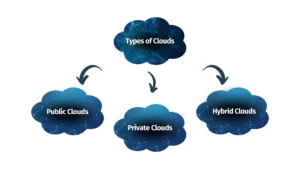Cloud computing has revolutionized the way businesses operate, offering innovative solutions that enable companies to access computing resources such as servers, storage, databases, networking, and software over the internet. Unlike traditional IT infrastructure, which requires significant investment in physical hardware and maintenance, cloud computing allows businesses to scale and manage resources on-demand with greater flexibility and efficiency.
In this article, we will explore the key benefits of cloud computing for businesses, focusing on how it enhances productivity, reduces costs, and facilitates business growth.
Key Benefits of Cloud Computing for Businesses
- Cost Savings: One of the most compelling advantages of cloud computing is its ability to reduce costs. Traditional IT infrastructure requires heavy upfront investment in hardware, software, and personnel for maintenance and updates. With cloud computing, businesses can avoid these capital expenditures and pay only for the resources they use, often referred to as the pay-as-you-go model. By leveraging cloud services, businesses can cut costs associated with server maintenance, software licenses, and energy consumption. Additionally, businesses do not need to invest in expensive data centers, as cloud providers like Amazon Web Services (AWS), Microsoft Azure, and Google Cloud handle infrastructure management.
- Scalability and Flexibility: Cloud computing offers businesses exceptional scalability and flexibility. As a company grows or experiences fluctuations in demand, it can easily scale its computing resources up or down without the need to purchase additional hardware. This flexibility allows businesses to handle varying workloads, such as seasonal spikes in traffic or rapid expansion, without worrying about resource limitations. Cloud providers offer various pricing tiers and service models, allowing businesses to choose the best option for their needs. The ability to scale quickly and efficiently helps businesses remain agile and competitive in a fast-changing market environment.
- Improved Collaboration: Cloud computing enhances collaboration among teams and departments by providing tools and platforms that enable real-time communication, document sharing, and collaboration. For example, cloud-based productivity tools like Google Workspace and Microsoft Office 365 allow employees to work together seamlessly from different locations. With cloud-based applications, teams can access and work on the same documents or projects simultaneously, regardless of their geographic location. This promotes greater teamwork and ensures that employees have access to the latest information and resources at all times, improving efficiency and decision-making.
- Accessibility and Mobility: Cloud computing allows employees to access business applications and data from any device with an internet connection, whether at the office, at home, or on the go. This mobility enhances workforce productivity and ensures business continuity, as employees can work remotely or during travel. By leveraging mobile-friendly cloud applications, employees can stay connected and productive, reducing downtime and enabling faster response times. This is particularly important in today’s globalized work environment, where teams may be spread across multiple time zones.
- Enhanced Security: Cloud providers invest heavily in robust security protocols, including data encryption, firewalls, multi-factor authentication (MFA), and continuous monitoring to ensure that business data remains protected. While some businesses may have concerns about the security of their data in the cloud, many cloud service providers meet or exceed industry-standard security certifications and compliance requirements. Additionally, cloud computing offers enhanced disaster recovery and backup solutions, which ensure that critical data is protected and can be restored in the event of a disaster or system failure. Cloud providers typically have multiple data centers located in different regions, providing redundancy and ensuring high levels of availability.
- Automatic Software Updates: Cloud computing eliminates the need for manual software updates and patches. Cloud providers regularly update their software and infrastructure to ensure that businesses are using the latest features and security patches. This reduces the burden on in-house IT teams and ensures that businesses benefit from the latest innovations and security improvements without any downtime or manual intervention. Automatic updates also ensure that businesses are compliant with the latest industry regulations, as cloud providers are responsible for keeping their systems up to date with evolving standards.
- Business Continuity and Disaster Recovery: Cloud computing offers built-in solutions for business continuity and disaster recovery. In the event of a hardware failure, power outage, or natural disaster, businesses can continue operating by accessing their data and applications from the cloud. Cloud-based systems are designed to be resilient and can automatically failover to backup servers in different locations, minimizing downtime and ensuring that critical business functions remain uninterrupted. The ability to quickly recover from disruptions is essential for businesses to maintain operations and customer trust.
- Environmentally Friendly: Cloud computing also offers environmental benefits, as it promotes the efficient use of resources. Instead of relying on multiple physical servers and data centers, cloud providers operate large-scale, energy-efficient data centers that maximize resource utilization and minimize waste. By consolidating computing resources in centralized locations, cloud computing reduces the overall environmental impact of IT infrastructure. Additionally, cloud providers are increasingly adopting renewable energy sources to power their data centers, further reducing their carbon footprint.
- Innovation and Competitive Advantage: Cloud computing enables businesses to innovate more rapidly by providing access to cutting-edge technologies such as artificial intelligence (AI), machine learning (ML), big data analytics, and Internet of Things (IoT). These technologies are often available as services through the cloud, allowing businesses to experiment and integrate them into their operations without significant upfront investment. By leveraging cloud-based tools and resources, businesses can streamline processes, enhance customer experiences, and develop new products and services, gaining a competitive edge in their industries.
- Simplified IT Management: Cloud computing reduces the complexity of IT management by outsourcing infrastructure maintenance and software updates to cloud service providers. Businesses no longer need to worry about managing physical servers, patching systems, or troubleshooting hardware issues, as the cloud provider handles these tasks. This allows internal IT teams to focus on more strategic initiatives, such as improving business processes, enhancing security measures, and developing new technologies to support growth. The simplification of IT management leads to greater efficiency and cost savings.
Conclusion
Cloud computing offers businesses numerous advantages, ranging from cost savings and scalability to improved collaboration and enhanced security. As organizations continue to embrace digital transformation, the cloud has become a vital tool for enabling business growth, improving operational efficiency, and fostering innovation.
By adopting cloud solutions, businesses can access cutting-edge technologies, streamline their operations, and ensure business continuity in a fast-paced, competitive world. As the technology continues to evolve, the cloud will remain a central element in shaping the future of business and IT.




